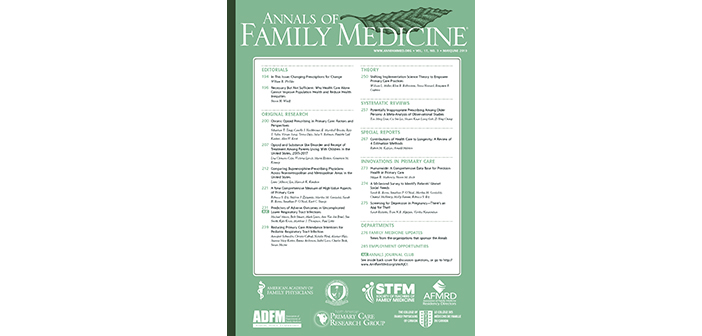Annals of Family Medicine finds a new home at Brown.
When Chair of Family Medicine Caroline Richardson, MD, moved from the University of Michigan to Brown last year, she brought along not only her expertise in the field but also one of the principal peer-reviewed publications within the specialty: Annals of Family Medicine. It’s one of the top journals globally for original primary care research, according to Senior Editorial Manager Ellen McCarthy.
The highly selective journal, published by the American Academy of Family Physicians, prioritizes quality content in all its publications, averaging about 70 articles annually with only a handful of core staff members, as well as 12 associate editors who evaluate manuscripts and help authors to develop them for publication, say Richardson and McCarthy.
“We see ourselves as curators, and then we see ourselves as disseminators as bringing attention to these good articles,” says Richardson, who assumed the role of editor in 2019. In line with the vision of the journal’s founders, who established the publication in the early 2000s, “we work very hard to find the best research out there that leads family medicine forward and has the highest rigor and relevance to family medicine-primary care implementation.”
The Annals of Family Medicine team regularly collaborates with peer publications in the field, where each journal has a predominant focus. They prioritize original research, such as randomized controlled trials and qualitative and mixed-methods research, but they also publish systematic reviews, concise research briefs, articles on innovative ideas applied within the field, and essays that convey the personal experiences of family medicine physicians, says Richardson, the George A. and Marilyn M. Bray Professor of Family Medicine.
Popular topics have included social determinants of health and technology within primary care, such as the potential for artificial intelligence to assist in clinic tasks like documentation and the use of point-of-care ultrasound for diagnostics, Richardson says. The journal also has published guidelines for researchers in primary care, known as the Consensus Reporting Items for Studies in Primary Care Checklist, or CRISP, McCarthy adds.
The team is thinking, “How can we best equip researchers and physicians with the most recent, up-to-date knowledge to help them provide the best care?” says Sofia Darovskikh, MS, the journal’s communication specialist.
Annals of Family Medicine is notable for its accessibility to readers and authors. Unlike many research publications, it does not levy author processing charges, and all articles are open access, according to McCarthy. The journal has been growing its online presence as well through social media and, beginning in May, with a podcast that discusses selected articles from the journal. Sherri Eldin MFA’14, DO, a resident physician who proposed the podcast, hopes that more people will engage with the journal’s content as a result.
Seven organizations within family medicine fund the journal, and the grant funding is associated with the editor’s institution—in this case Brown, says Richardson. While the staff who were originally affiliated with the journal through the University of Michigan had to transition their affiliation to Brown when the journal moved locations, they have successfully continued their work together virtually from different parts of the country.
Annals of Family Medicine is continuing to grow as it settles into its new home. Maintaining the journal in its first year at Brown with a limited staff was “a real trial,” McCarthy says, but “everything is coming together right now.”




